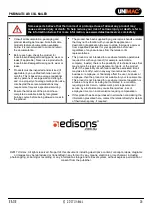
Pneumatic Air Coil Nailer
E&OE
© 2017 Unimac
6
Operating Instructions
Foreword
The Pneumatic Air Coil Nailer is a heavy duty, coil-fed, pneumatic nailer using compressed air as a power
source. It is designed to install 1 – ¼” to 2 – ½” or 0.091” – 0.114” diameter nails of various lengths. It is widely
used for the connections of frame and of both frame and felt. The tool has a magnesium alloy body and the
cylinder cap is made of a light material that provides, high specific strength and rigidity.
Power Source
This tool is designed to operate on clean, dry, compressed air at regulated pressures between 70 and 120 PSI
(4.9 and 8.3 bar).
The preferred system would include a filter (C) Fig.2, a pressure regulator (A) Fig. 2, and automatic oiler (B)
Fig.2 located as close to the tool as possible (within15 feet is ideal).
All compressed air contains moisture and other contaminants that are detrimental to internal components of the
tool. An airline filter will remove most of these contaminates and significantly prolong the life of the tool. If an in-
line oiler is not available, place five or six drops of tool oil into the tool’s air inlet at the beginning of each
workday.
Only disconnect the quick connector with the body tail portion of the air inlet. No compressed air can be
guaranteed when disconnecting. If operation is incorrect, the tool can remain charged with air after being
disconnected and still be able to fire a fastener, causing personal injury.
CAUTION
: All line components (hoses, connectors, filters, regulators, etc.) must meet 150% of the maximum
system pressure. Please try to use a hose of ID 3/8” connecting the nailer with the compressor when
disconnecting.
Do not connect this tool to a system with maximum potential. Only disconnect the quick connector being
connected with the connector of the body tail portion air inlet, no compressed air can be guaranteed when
moving to another location or handing the tool to another person.
Disconnect the tool from the air supply before performing maintenance, clearing a jammed fastener, leaving the
work area, moving the tool to another location or handing the tool to another person.

































